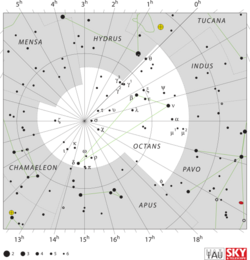Astronomy:Omega Octantis
| Observation data Epoch J2000.0 Equinox (celestial coordinates) | |
|---|---|
| Constellation | Octans |
| Right ascension | 15h 11m 08.79214s[1] |
| Declination | −84° 47′ 16.0295″[1] |
| Apparent magnitude (V) | 5.87±0.01[2] |
| Characteristics | |
| Evolutionary stage | main sequence[3] |
| Spectral type | B9.5 V[4] |
| U−B color index | −0.13[5] |
| B−V color index | −0.06[5] |
| Astrometry | |
| Radial velocity (Rv) | −7.6±3[6] km/s |
| Proper motion (μ) | RA: +2.984[1] mas/yr Dec.: −9.385[1] mas/yr |
| Parallax (π) | 9.9406 ± 0.0591[1] mas |
| Distance | 328 ± 2 ly (100.6 ± 0.6 pc) |
| Absolute magnitude (MV) | +0.94[7] |
| Details | |
| Mass | 2.54[3] M☉ |
| Radius | 2.35±0.06[8] R☉ |
| Luminosity | 50.5+2.5−2.4[3] L☉ |
| Surface gravity (log g) | 4.21[9] cgs |
| Temperature | 10,759±366[9] K |
| Metallicity [Fe/H] | 0.00[10] dex |
| Rotational velocity (v sin i) | 36[11] km/s |
| Age | 197[9] Myr |
| Other designations | |
| Database references | |
| SIMBAD | data |
Omega Octantis, (latinized from ω Octantis), is a solitary,[13] bluish-white hued star located in the southern circumpolar constellation Octans. It has an apparent magnitude of 5.87,[2] allowing it to be faintly seen with the naked eye. Based on the object's parallax measurements, it is estimated to be 328 light years distant.[1] However, it is drifting closer with a heliocentric radial velocity −7.6 km/s.[6]
Omega Octantis has a stellar classification of B9.5 V,[4] indicating that it is a main-sequence star between the B9 and A0 classes. Helmut A. Abt & Nidia I. Morrell gave a slightly updated class of B9.5 Vs,[14] which includes sharp (narrow) absorption lines in Omega Octantis' spectrum due to slow rotation. It has a mass 2.54 times that of the Sun[3] and is calculated to be 197 million years old,[9] having completed 40% of its main sequence lifetime.[3] It has a luminosity of 50.5 L☉,[3] which comes from a radius of 2.35 R☉ and an effective temperature of 10,759 K. In 2012, George A. Gontcharov calculated a solar metallicity for Omega Octantis,[10] and it is spinning modestly with a projected rotational velocity of 36 km/s.[11] The slow rotation is consistent with the spectral classification from Abt & Morell (1995).[14]
References
- ↑ 1.0 1.1 1.2 1.3 1.4 Vallenari, A. et al. (2022). "Gaia Data Release 3. Summary of the content and survey properties". Astronomy & Astrophysics. doi:10.1051/0004-6361/202243940 Gaia DR3 record for this source at VizieR.
- ↑ 2.0 2.1 Høg, E.; Fabricius, C.; Makarov, V. V.; Urban, S.; Corbin, T.; Wycoff, G.; Bastian, U.; Schwekendiek, P. et al. (March 2000). "The Tycho-2 catalogue of the 2.5 million brightest stars". Astronomy and Astrophysics 355: L27–L30. ISSN 0004-6361. Bibcode: 2000A&A...355L..27H.
- ↑ 3.0 3.1 3.2 3.3 3.4 3.5 Zorec, J.; Royer, F. (January 2012). "Rotational velocities of A-type stars. IV. Evolution of rotational velocities". Astronomy and Astrophysics 537: A120. doi:10.1051/0004-6361/201117691. ISSN 0004-6361. Bibcode: 2012A&A...537A.120Z.
- ↑ 4.0 4.1 Houk, N.; Cowley, A. P. (1975). University of Michigan Catalogue of two-dimensional spectral types for the HD stars. Volume I. Declinations −90° to −53°. Bibcode: 1975mcts.book.....H.
- ↑ 5.0 5.1 Johnson, H. L.; Mitchell, R. I.; Iriarte, B.; Wisniewski, W. Z. (1966). "UBVRIJKL Photometry of the Bright Stars". Communications of the Lunar and Planetary Laboratory 4: 99–110. Bibcode: 1966CoLPL...4...99J.
- ↑ 6.0 6.1 Gontcharov, G. A. (November 2006). "Pulkovo Compilation of Radial Velocities for 35 495 Hipparcos stars in a common system". Astronomy Letters 32 (11): 759–771. doi:10.1134/S1063773706110065. ISSN 1063-7737. Bibcode: 2006AstL...32..759G.
- ↑ Anderson, E.; Francis, Ch. (May 2012). "XHIP: An extended hipparcos compilation". Astronomy Letters 38 (5): 331–346. doi:10.1134/S1063773712050015. ISSN 1063-7737. Bibcode: 2012AstL...38..331A.
- ↑ Stassun, Keivan G. et al. (9 September 2019). "The Revised TESS Input Catalog and Candidate Target List". The Astronomical Journal 158 (4): 138. doi:10.3847/1538-3881/ab3467. Bibcode: 2019AJ....158..138S.
- ↑ 9.0 9.1 9.2 9.3 David, Trevor J.; Hillenbrand, Lynne A. (12 May 2015). "The Ages of Early-type Stars: Strömgren Photometric Methods Calibrated, Validated, Tested, and Applied to Hosts and Prospective Hosts of Directly Imaged Exoplanets". The Astrophysical Journal 804 (2): 146. doi:10.1088/0004-637X/804/2/146. Bibcode: 2015ApJ...804..146D.
- ↑ 10.0 10.1 Gontcharov, G. A. (December 2012). "Dependence of kinematics on the age of stars in the solar neighborhood". Astronomy Letters 38 (12): 771–782. doi:10.1134/S1063773712120031. ISSN 0320-0108. Bibcode: 2012AstL...38..771G.
- ↑ 11.0 11.1 Levato, H.; Grosso, M. (June 2004). "New Projected Rotational Velocities of All Southern B-type Stars of the Bright Star Catalogue". Astronomical Society of the Pacific 215: 51. Bibcode: 2004IAUS..215...51L.
- ↑ "Omega Oct". SIMBAD. Centre de données astronomiques de Strasbourg. http://simbad.u-strasbg.fr/simbad/sim-basic?Ident=Omega+Oct.
- ↑ Eggleton, P. P.; Tokovinin, A. A. (11 September 2008). "A catalogue of multiplicity among bright stellar systems". Monthly Notices of the Royal Astronomical Society 389 (2): 869–879. doi:10.1111/j.1365-2966.2008.13596.x. ISSN 0035-8711. Bibcode: 2008MNRAS.389..869E.
- ↑ 14.0 14.1 Abt, Helmut A.; Morrell, Nidia I. (July 1995). "The Relation between Rotational Velocities and Spectral Peculiarities among A-Type Stars". The Astrophysical Journal Supplement Series 99: 135. doi:10.1086/192182. ISSN 0067-0049. Bibcode: 1995ApJS...99..135A.
<ref> tag with name "Gould1879" defined in <references> is not used in prior text.
 |


